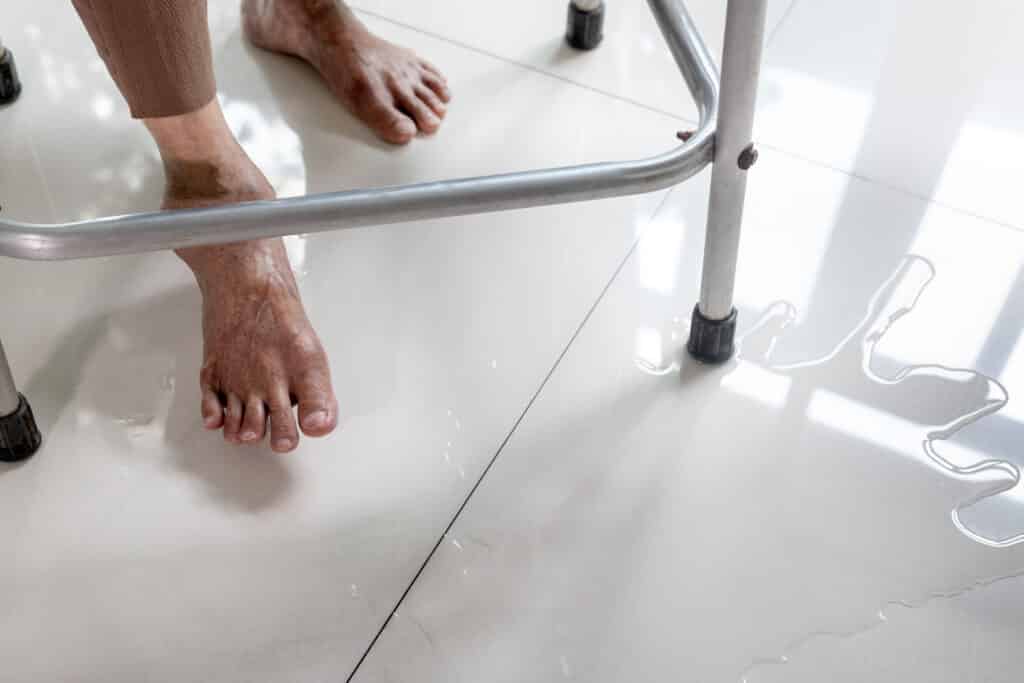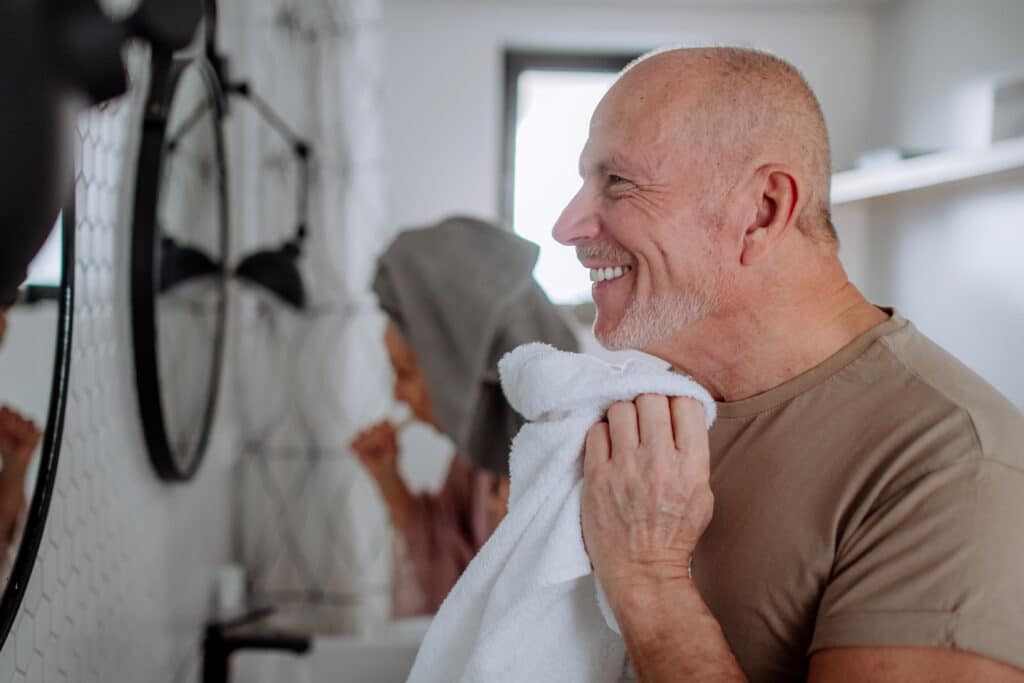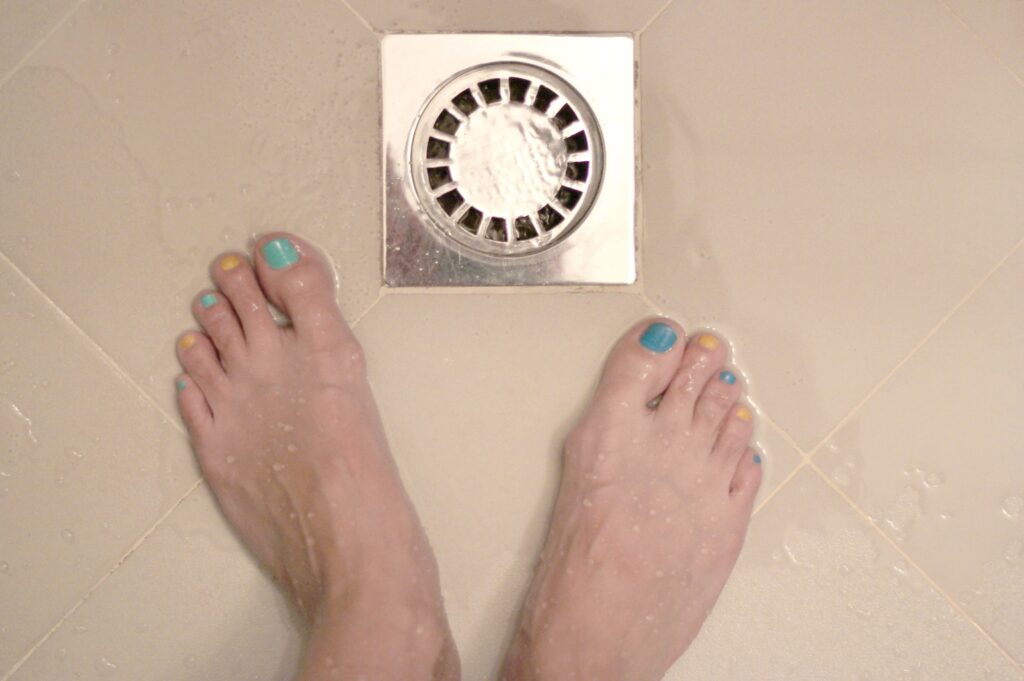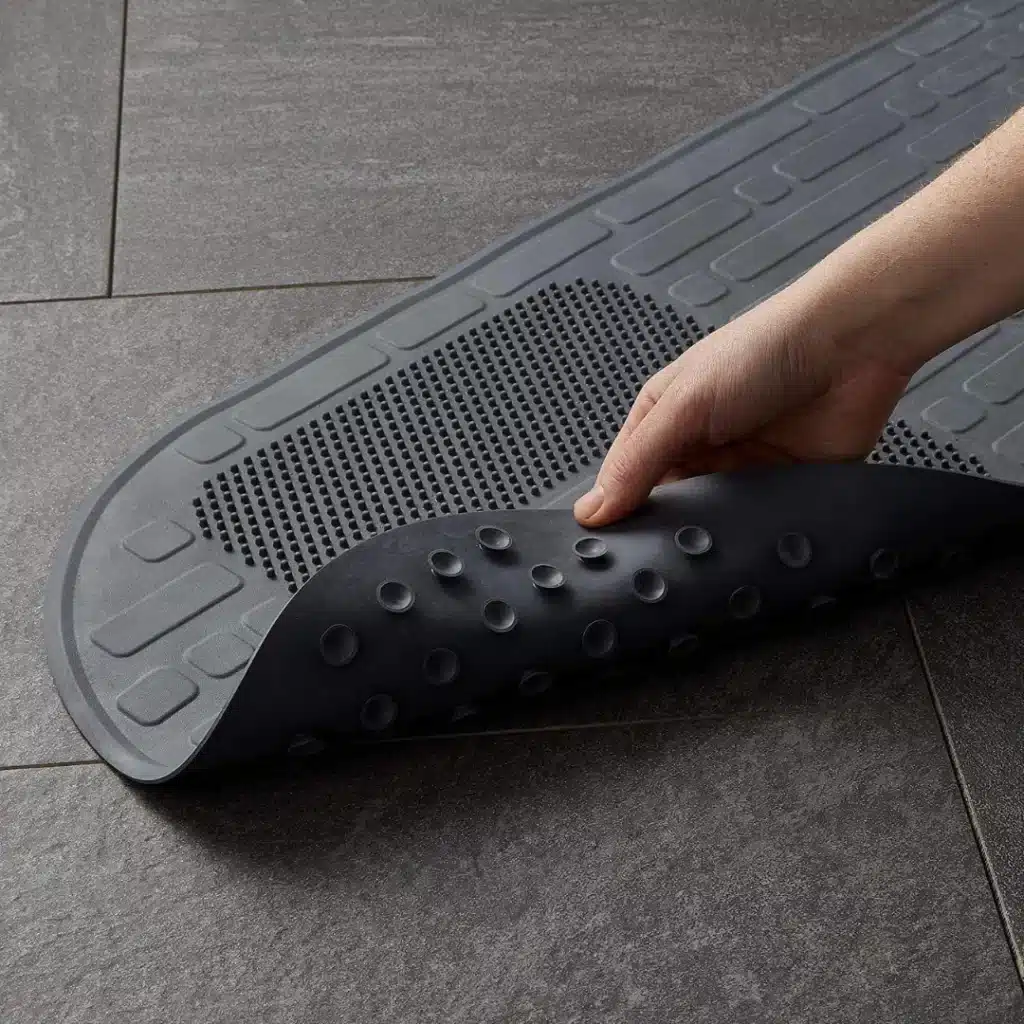Approximately 235,000 people annually encounter bathroom-related injuries, with about 14% resulting in hospitalization. These alarming statistics highlight the importance of fall prevention, especially as we age and face challenges with balance and coordination.
This article delves into the common causes of bathroom falls, such as slippery floors and coordination problems, and offers practical solutions for prevention. From installing safety equipment to performing balance exercises and regular checkups, we provide a comprehensive guide to reduce your risk of becoming a statistic in bathroom fall injuries.
Causes of Falling in the Bathroom

What are the hazards in the bathroom? Understanding what causes falling in the bathroom is a crucial preventive measure. You can upgrade your bathroom to mitigate these causes and prevent slipping and tripping. Here are the primary causes of falling in the bathroom.
Slippery Floors
Slippery floors are one of the most common causes of falls. When the floors are slippery, they can reduce the friction between your feet and the floor. The type of shoes you wear can also increase the slipping rates. Shoes that have smooth soles provide little traction for your feet.
Instead, the best footwear for preventing falls in the bathroom is made with quick-dry material while incorporating ergonomic comfort and a non-slip sole into the design. Shower sandals such as the Xomiboe Shower Shoes are excellent because they dry quickly and use a non-slip material to ensure stability while in the shower.
If the room is made from smooth, slick material like linoleum or vinyl, you can be at a higher risk of falling. Because the floor appears naturally smooth, it can be hard to see whether you are walking on a potentially slippery floor. Therefore, it is best to treat every floor as slick.
Coordination Problems
When you walk, difficulty with balance and wobbling can increase the risk of slipping and falling. Poor health conditions can reduce your ability to maintain balance. For example, if you have arthritis, you can experience numb knees when getting out of the bathtub or shower stall.
You can also experience difficulties in hand-eye coordination. Lack of proper coordination reduces the effectiveness of using hands properly to hold on to something. The result is a fall on the floor — or even into the bathtub.
Poor Visibility
Poor bathroom lighting can make it difficult to see what is around you. The problem can increase if there is light overhead. Visibility problems leave you vulnerable to tripping over.
Additionally, if your bathroom has bright lights shining directly into your eyes, you can experience poor visibility. When this happens, it can cause temporary blindness. You can bump into objects like toilet seats or towel racks and fall.
Lack of Safety Measures
Safety is a primary concern for many people. However, most people do not think about it in the bathroom. Safety measures should always be present to prevent injuries from occurring.
If there is no grab rail near the bathtub, you can trip and fall when getting out. A grab rail can help you rest your arms and support yourself while bathing. If the bathroom lacks a grab rail, it increases the risk of slipping and falling. It is difficult for someone with weak wrists to hold onto the bathroom walls while bathing.
5 Tips For Preventing Falling in the Bathroom

Falling in the bathroom is a common occurrence. However, you can prevent this by upgrading your bathroom and following simple safety advice. Here are some general tips on preventing falls in the shower and the bathroom.
Maintain Dry Floors
Maintaining dry floors is essential when talking about bathroom fall prevention. They can help reduce the risk of slipping and falling while getting into the bathroom. Stepping on a wet floor increases the risk of falling in the bathroom. Clean the floor regularly by sweeping up any debris that has fallen on the floor.
You can use a dry towel or mop to help remove water from the floor. You can also prevent water buildup from steam by using a dehumidifier. Maintaining dry floors will help reduce the moisture in the bathroom and make it less slippery when wet.
Use Non-Slip Mats
Non-slip mats have rough textured bottoms that prevent slipping while in the shower. It makes it easier for you to stand on your feet. Using a non-slip mat can increase the stability of the smooth bathroom tiles.
OUR RECOMMENDATION
The Medline Rubber Bath Mat is our recommendation for a solid, slip-free bath mat. It has 300(!) suction cups on the bottom to keep it in place. The rubber is soft and pliable, so it lays nice and flat without curling. It is mold- and mildew-resistant, which is always a bonus. Also, it has this neat textured foot scrubbing area that massages your feet when you want it. This is the easiest upgrade to your shower and bath safety that you can make today.
Our recommendations are the same items we trust and prescribe to patients. When you buy through links like this on our site, we may earn an affiliate commission to support new content.
Safety Measures
The most important safety measure is to repair loose tiles or remove loose shower steps in the bathroom. Loose tiles or shower steps can easily trip you when getting a shower. If you can not remove the loose shower step in time, it is vital to have adequate lighting in the bathroom.
You can also install grab bars on the wall. The grab bars will assist in gaining stability and balance when getting in and out of the bathroom. Installing grab bars makes it easier for someone with limited mobility.
Balance Exercises to Prevent Bathroom Falls
Exercise helps you maintain good balance and coordination. Regular exercise can increase your flexibility and stability. After exercising, you are less likely to fall when you are on your feet. If you already have balance problems, exercise can help you build strength and stamina.
Making a daily habit of conducting easy exercises can improve your stamina and agility while vastly reducing your chances of experiencing a fall. Practicing simple balance exercise is a great way to keep your body flexible and moving no matter how old you are. These exercises are low-intensity and easy to complete right in the comfort of your home.
Regular Checkups
Ensure you get a checkup regularly, especially if you’re having trouble with your balance. Your doctor can recommend that you see a physical therapist for some exercises. The exercises can strengthen muscles in your legs and feet.
What To Do After Falling in the Bathroom
After falling in the bathroom and suffering an injury, you can take a few essential steps to help yourself. Read these tips and learn what to do after falling in the shower or somewhere else in the bathroom.
Stay Calm and Take a Deep Breath
If you fall in the bathroom, remaining as calm as possible is essential. The National Institute of Aging states that taking a deep breath and staying calm can help overcome the fall’s initial shock. Check for injuries —You should not attempt to move if you notice or feel an apparent injury.
Check for Injuries
Taking a minute to scan your body for potential injuries is essential. Injuries can range from broken bones, cuts, or bruises to severe head trauma. Here are a few possible warning signs of a broken bone:
- You notice swelling or bruising on your arm or leg.
- Your leg or arm experiences pain when you move it.
- Your arm or leg looks “out of shape” or deformed.
- Your limb flops around, and you cannot control it.
Seek Medical Attention
If you think you may have fractured a bone, see a doctor right away. In most cases, the pain will go away after a few days. However, if your pain does not improve or you have trouble moving, call your doctor immediately. You can visit the doctor’s office for consultation and medication after the fall.
While it may seem inconvenient to improve the safety of your bathroom, falling in the bathroom can be dangerous. If you fall while showering or bathing, you can sustain injuries on your head, neck, and back. However, many bathroom slip and fall accidents are preventable.
You can reduce your fall risk by being aware of the dangers and taking precautions. You should remember the preventive measures and what to do if you fall. The measures can help save your life someday.
Key Takeaways
- Around 235,000 people suffer injuries from bathroom falls each year, with 14% leading to hospitalization, underscoring the need for preventive measures.
- Primary causes of bathroom falls include slippery floors, coordination problems, poor visibility, and lack of safety measures like grab bars.
- Preventative strategies include maintaining dry floors, using non-slip mats, installing safety measures, performing balance exercises, and having regular checkups.
- Specific products like Xomiboe Shower Shoes and the Medline Rubber Bath Mat can significantly enhance bathroom safety.
- In a fall, staying calm, assessing for injuries, and seeking medical attention if necessary is crucial.
Resources
- Nonfatal Bathroom Injuries Among Persons Aged ≥15 Years — United States, 2008 (cdc.gov)
- Stevens JA, Mahoney JE, Ehrenreich H. Circumstances and outcomes of falls among high-risk community-dwelling older adults. Inj Epidemiol. 2014 Mar 20;1(5):5. doi: 10.1186/2197-1714-1-5. PMID: 26744637; PMCID: PMC4700929.
- https://www.nia.nih.gov/health/falls-and-fractures-older-adults-causes-and-prevention







